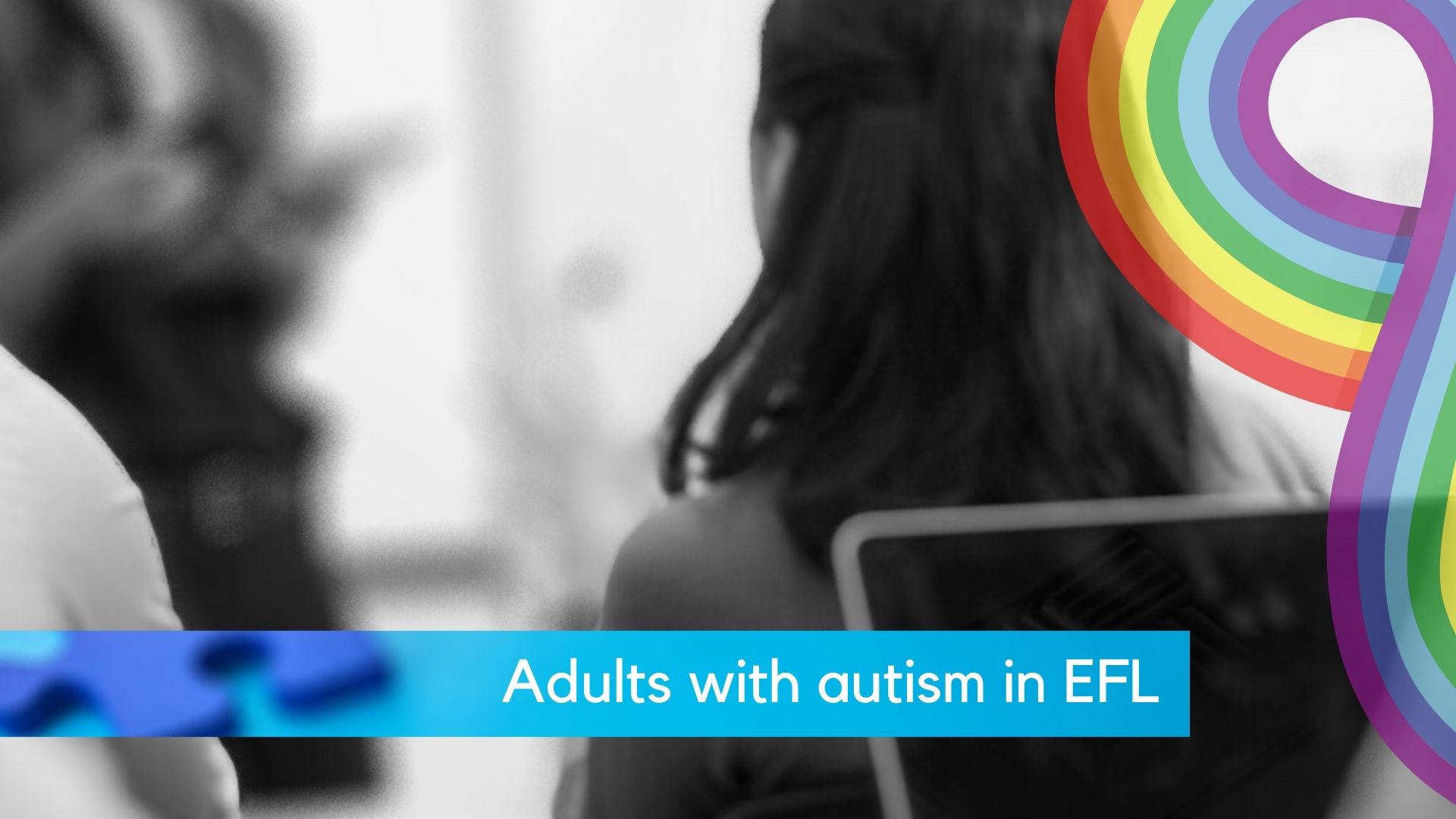
Adults with Autism in EFL.
According to the United Nations , “The narrative around autism is gradually moving away from misconceptions of curing and converting autistic people to an inclusive approach focusing on accepting, supporting and involving autistic people, and embracing the concept of neurodiversity — the idea that people experience and interact with the world in many different ways and that there is no one ‘right’ way.”
So, what does this all mean for both learners and teachers of EFL alike? Autism affects the way people communicate and interact with others, as well as their learning style and preferences. The shift in narrative described by the UN, therefore, has profound implications for the EFL sector if it is to ensure inclusivity and avoid discrimination.
What is autism?
The UK’s Autism Research Centre at Cambridge University defines autism as, “A set of neurodevelopmental differences and disabilities,” which means that, “Autistic people experience and respond to the world around them in a different way.” The website goes on to explain that only “one in three people have general learning disabilities.” This is important to highlight because the challenges faced by the remaining two-thirds of the autistic community can easily be overlooked due to widespread ignorance about how autism presents in people. Stereotypes based on fictional characters. such as Raymon Babbit in Rain Man, remain entrenched in popular consciousness. In reality, autism manifests itself differently in every person. In some cases, autistic traits can be largely imperceptible and the condition undiagnosed well into adulthood as a result of masking.
What is masking?
Masking is a mechanism people use to hide or camouflage their autistic traits in order to fit in and get by in a neurotypical world. It is not a deceptive practice as such, despite the connotations of the word, but rather a social survival strategy which is often done unconsciously. Dr Hannah Bletcher, author of Taking off the Mask, explains:
“Masking may involve suppressing certain behaviours we find soothing but that others think are ‘weird’, such as stimming or intense interests. It can also mean mimicking the behaviour of those around us, such as copying non-verbal behaviours, and developing complex social scripts to get by in social situations. With this comes a great need to be like others, and to avoid the prejudice and judgement that comes with being ‘different’.”
High-masking individuals often go undiagnosed during childhood and can muddle through life without fully understanding the true nature of the difficulties they face. On the surface, they may appear to fit in with the people around them by suppressing their autistic traits. But this often comes at a great personal expense, resulting in things such as emotional exhaustion, anxiety, depression and regular burnout.
As a society, therefore, we need to create an environment where people with autism do not feel the need to suppress or overcome their autistic traits. This means embracing the idea of neurodiveristy in all aspects of life rather than perpetuating the social expectation to conform to a neurotypical ‘ideal’.
Adult EFL learners with autism
Given that autism presents in so many different ways and - as in the case of high-masking adults - may not even be perceptible at all, what, if anything, can the TEFL sector do to become more inclusive? Before considering this question, it may be worth looking at just a few of the traits that are sometimes associated with autism.
Difficulty in switching from one activity to another is sometimes described as an autistic trait, as is the need for more time to process information. Some people with autism are reported to take things literally and have difficulty understanding metaphors, jokes, euphemisms or abstract language. Challenges with social interaction can include difficulty reading social cues, such as when it’s acceptable to join in a conversation or when to let others speak, not to mention difficulties engaging in small talk.
Autistic people can sometimes feel overwhelmed in the company of others and seek time alone as a consequence. Sensitivities to sounds, smells, bright lights, touch and taste can lead to stress or discomfort in some autistic people. Changes to routine can cause anxiety, while repetitive behaviours can be soothing.
This list is by no means exhaustive and not every autistic person experiences the world in these ways. Although it may be easy to imagine how some EFL classrooms and teaching methods can be challenging for people with a combination of several of these traits, it would be unwise to make any generalisations here. The National Autistic Society in the UK, as well as many other organisations, provide tips on how to make educational settings more autism-friendly, but it’s useful to remember that every autistic person is different. As autism awareness advocates often say, “If you’ve met one autistic person, you’ve met one autistic person.”
To return to the question, then, about what we can do to make TEFL more inclusive for adults with autism, the best answer may in fact be the simplest: ask your learners. That’s not to say you should ask them if they identify as autistic or go about trying to identify autistic traits in them yourself. Some people may not feel comfortable disclosing their diagnosis, or may not even be aware that they are autistic, as already mentioned. Instead, we should first and foremost make any learners with traits associated with autism feel accepted and try to foster a supportive culture of acceptance among all learners in the classroom.
For those who do disclose a diagnosis, it’s important to ask them directly if there are any adaptations that could help. In a sense, the best teachers of EFL make appropriate adjustments already, without the need to identify or name conditions such as autism. Individual needs analysis is central to English language learning success and no two learners have the same profile. Tailoring to individual needs should therefore be part and parcel of any EFL programme.
But with growing awareness about autism, it may be that we need to go a step further and re-consider or broaden our notions of what is acceptable in terms of things like speech patterns, communication styles or non-verbal forms of expression. At the same time, it may be necessary to explore ways of imparting English language skills without ‘correcting’ idiosyncrasies that are integral to a person’s identity.
Finally, it’s important to stress that there’s nothing inherently disabling about autism when it comes to second language acquisition. Indeed, a study conducted by researchers at the University of Edinburgh found that, “Similar to their non-autistic peers, autistic people can know several languages.” This would indicate that any barriers faced by autistic people in EFL are caused by disabling learning environments or teaching approaches, rather than autism itself. Finding ways of making TEFL more inclusive by default, therefore, is the first step to giving autistic people the same opportunities as everyone else to reach their full potential.
Archive
Tag Cloud
Train to Teach
SEE The World
Step this way and join us in Chiang Mai, Thailand for an opportunity to teach English to the World: 4 weeks of onsite training including 6 observed teaching practices at local schools followed by a job guarantee.
www.seetefl.comFace-to-face and fully online CELTA courses, AVO Centre - Bulgaria
Small groups, personal approach and individual support. Highly qualified and supportive tutors. Very high pass rate. Apply now and book your place!
www.teflcertificates-avo.comGet your TEFL Trinity CertTESOL Certificate on the beach in sunny Spain!
Full-time & Part-time Courses, both Online and Face-to-face options available. Job placement & Student Visa Programmes.
www.tefl-in-malaga.comTEFL Trinity CertTESOL Courses in Rome, Italy!
Full-time & Part-time Courses, both Online and Face-to-face options available. Job placement & Student Visa Programmes. Sign up now!
www.tefl-in-italy.com150-hour TEFL Certification + Job-Placement Guarantee, in Latin America & Online!
With 20+ years of ESL expertise, Maximo Nivel's award-winning TEFL course combines hands-on training with theory to successfully teach all over the world.
www.maximonivel.comPromote your training courses at TEFL.com for less than £10.00/€11.00/$13.00 per week!
Reach more than 100,000 potential students each month with Train to Teach targeted advertising via our platform, social media, apps & newsletters.
Download our Advertising Media Pack



